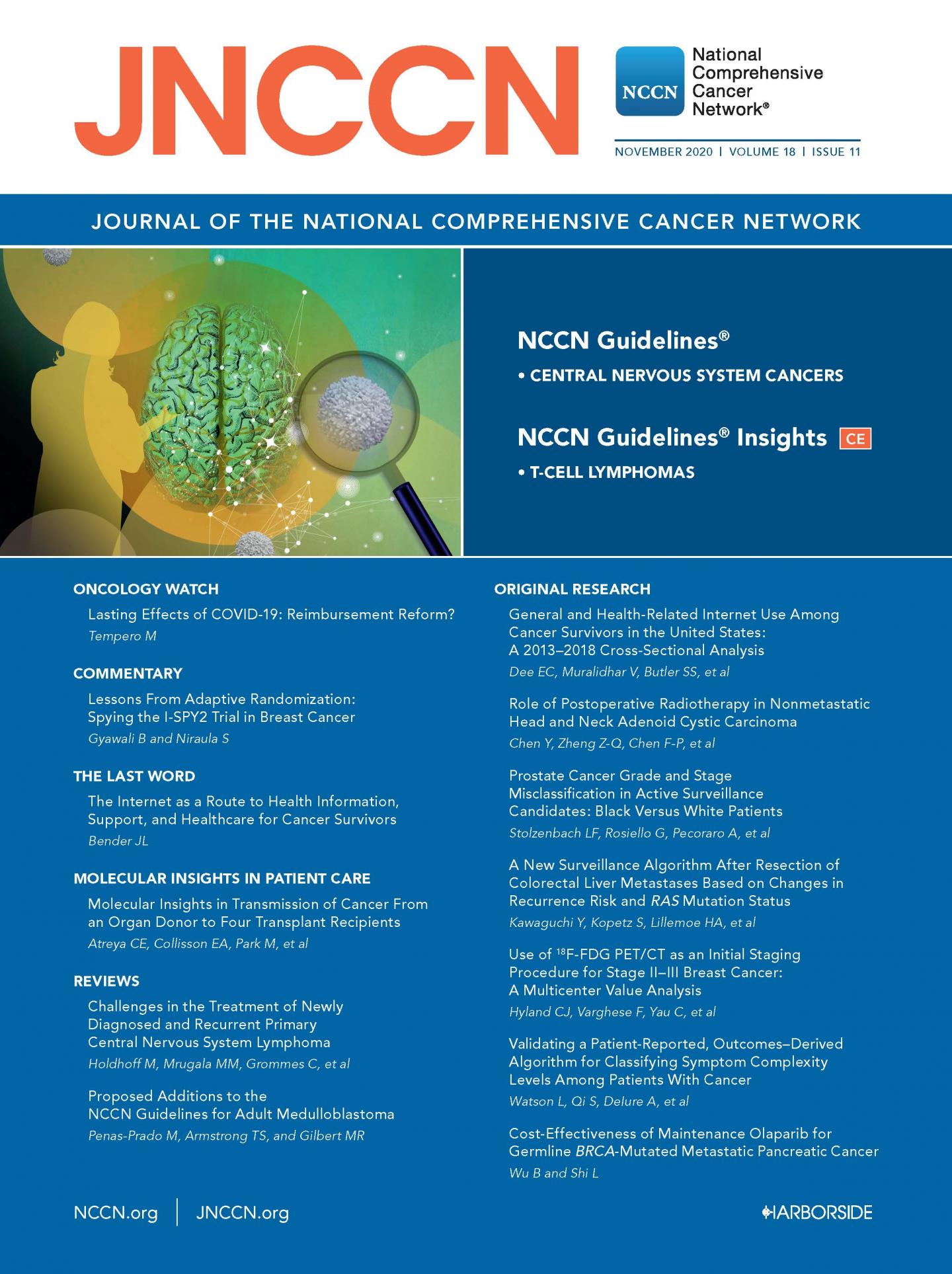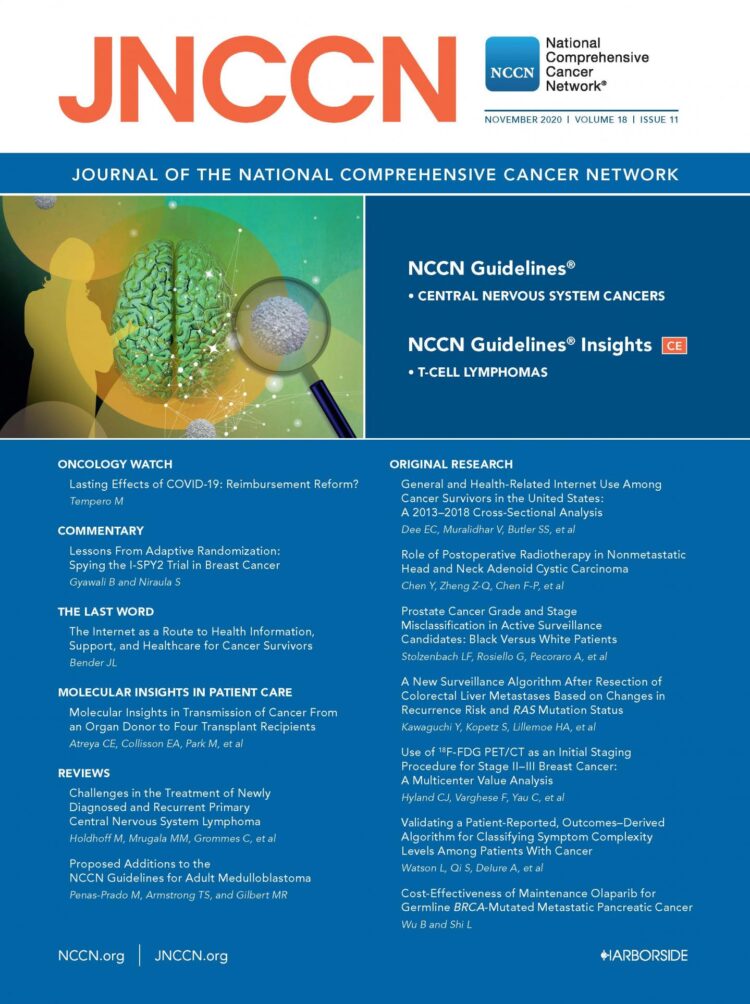Data from the POLO trial was analyzed to determine which patient groups with pancreatic cancer would derive the most benefit from maintenance olaparib

Credit: NCCN
PLYMOUTH MEETING, PA [November 12, 2020] — Studies have shown that utilizing a PARP inhibitor in the management of patients with metastatic pancreatic cancer who harbor BRCA 1/2 mutations is clinically beneficial [1]. New research in the November 2020 issue of JNCCN–Journal of the National Comprehensive Cancer Network sheds further light on this subject through cost-effectiveness analysis. The investigators seek to identify patient subgroups with the highest relative cost-effectiveness, through models based on efficacy and toxicity data from the Pancreas Cancer Olaparib Ongoing (POLO) trial, and measuring it against cost per quality-adjusted life year (QALY).
“With the present clinical evidence, olaparib should be prescribed for patients with metastatic pancreatic cancer harboring a germline BRCA 1/2 mutation, especially after the first-line platinum-based chemotherapy has been successfully completed,” said researcher Lizheng Shi, PhD, School of Public Health and Tropical Medicine, Tulane University. “Our economic analysis found that olaparib might be a cost-effective option for patients, particularly if we select for optimal sub-groups, such as those who completed at least 16 weeks of continuous first-line platinum-based chemotherapy.”
Bin Wu, PhD, of Shanghai Jiaotong University in China, who co-authored this study also pointed out: “The cost-effectiveness of olaparib as measured by cost-per-QALY is reasonably close to the commonly used willingness-to-pay thresholds. The value of olaparib maintenance would be even more attractive if the price were lower.”
The researchers calculated incremental cost-utility ratios (ICUR) for patients taking maintenance olaparib versus those taking a placebo. Medical costs included drug acquisition, costs attributed to health states, costs for managing adverse effects, and costs for end-of-life care. All were calculated and considered based on 2018 U.S. dollar values. Modeling suggested that maintenance olaparib would be cost-effective in certain scenarios, using a threshold of $200,000 per QALY gained.
“While there is emerging evidence that precision medicine is relevant to subsets of patients with advanced pancreatic cancer, definitive results to support the cost-effectiveness of maintenance olaparib is lacking,” commented Robert A. Wolff, MD, The University of Texas MD Anderson Cancer Center. Dr. Wolff is a member of the NCCN Guidelines® Panel for Pancreatic Adenocarcinoma and was not involved in this study. “Cost-effectiveness analyses of PARP inhibitors used in similar patient populations with recurrent ovarian cancer have been negative [2]. Thus, either improved patient selection for maintenance olaparib or reduced drug costs are likely necessary to establish olaparib as a cost-effective therapy in metastatic pancreatic cancer.”
###
To read the entire study, visit JNCCN.org. Complimentary access to “Cost-Effectiveness of Maintenance Olaparib for Germline BRCA-Mutated Metastatic Pancreatic Cancer” is available until February 10, 2021.
[1] Golan T, Hammel P, Reni M, et al. Maintenance olaparib for germline BRCA-mutated metastatic pancreatic cancer. N Engl J Med 2019;381: 317-327.
[2] Smith, HJ et al. Gynecol Oncol, 2015; Zhong, L et al. J Manage Care Spec Pharm, 2018; Liu, AY et al. Gynecol Oncol, 2018
About JNCCN–Journal of the National Comprehensive Cancer Network
More than 25,000 oncologists and other cancer care professionals across the United States read JNCCN–Journal of the National Comprehensive Cancer Network. This peer-reviewed, indexed medical journal provides the latest information about innovation in translational medicine, and scientific studies related to oncology health services research, including quality care and value, bioethics, comparative and cost effectiveness, public policy, and interventional research on supportive care and survivorship. JNCCN features updates on the NCCN Clinical Practice Guidelines in Oncology (NCCN Guidelines®), review articles elaborating on guidelines recommendations, health services research, and case reports highlighting molecular insights in patient care. JNCCN is published by Harborside. Visit JNCCN.org. To inquire if you are eligible for a FREE subscription to JNCCN, visit http://www.
About the National Comprehensive Cancer Network
The National Comprehensive Cancer Network® (NCCN®) is a not-for-profit alliance of leading cancer centers devoted to patient care, research, and education. NCCN is dedicated to improving and facilitating quality, effective, efficient, and accessible cancer care so patients can live better lives. The NCCN Clinical Practice Guidelines in Oncology (NCCN Guidelines®) provide transparent, evidence-based, expert consensus recommendations for cancer treatment, prevention, and supportive services; they are the recognized standard for clinical direction and policy in cancer management and the most thorough and frequently-updated clinical practice guidelines available in any area of medicine. The NCCN Guidelines for Patients® provide expert cancer treatment information to inform and empower patients and caregivers, through support from the NCCN Foundation®. NCCN also advances continuing education, global initiatives, policy, and research collaboration and publication in oncology. Visit NCCN.org for more information and follow NCCN on Facebook @NCCNorg, Instagram @NCCNorg, and Twitter @NCCN.
Media Contact
Rachel Darwin
[email protected]
Original Source
https:/
Related Journal Article
http://dx.





